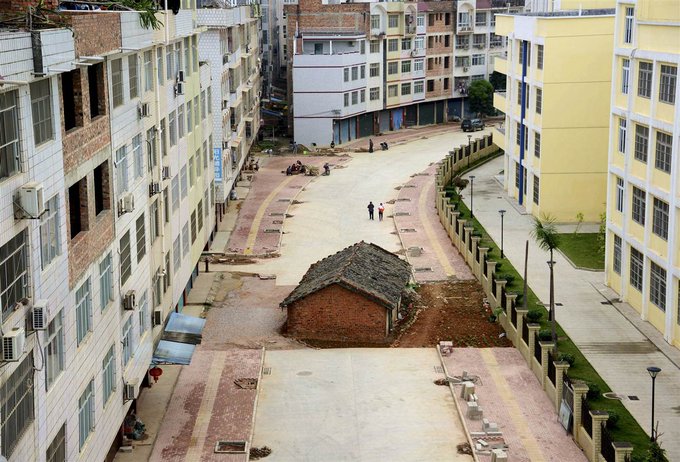Stubborn Homeowners Who Refused To Move

June 14, 2022
•10 min read
Let's find out about some stubborn people that refused to move.
Most people have heard of Pixar’s Up, but did you know the movie was inspired by real-world events? It turns out real people go to crazy lengths to avoid moving out of their homes. From mid-airport abodes to matchstick nail-houses, let’s explore the world’s most stubborn and brave homeowners who refused to sell their houses and move out.
Edith Macefield
Edith Macefield became a folk hero in 2006 when she turned down a million-dollar offer for her little Seattle farmhouse. The planned five-story commercial development continued regardless, but had to awkwardly build around Macefield’s 108-year-old house, where she remained until her death in 2008, aged 86.
In her will, she left the house to the new building’s construction superintendent, who had incidentally become a personal friend and caretaker to her. In 2009, Disney publicists tied balloons to the roof of Edith’s house as a promotion for the movie Up. It’s even rumoured that Edith’s story was the inspiration for the film. Carl Fredricksen would be proud.Half House
In 1957, Windlass Holdings started to buy up all the property in St. Patrick Street, Toronto. Their takeover plan was going smoothly until they ran into house number 54 ½. Bizarrely, it was already named number 54 ½ before it actually became half a house.
Half of the duplex sold, but the other half refused. So, the developers very carefully tore down half of the building, leaving the load-bearing divider wall intact. It’s remained in this strange state ever since and is currently occupied, so you’ll have to halve your own house for now.Nail Houses
Stubborn homeowners have become something of a phenomenon in China. The abodes of these homeowners are known as nail houses because their owners remain stuck in place like hammered-in nails. In some cases, after the surrounding architecture has been torn down, the buildings even resemble nails.
The Chinese government has considerable trouble getting rid of these people, who refuse to move regardless of how much money they’re offered. In retaliation, the government plays dirty, by cutting power lines and even digging moats around some houses.Airport Farming
Narita airport, Tokyo’s main international airport, had a controversial opening in 1978 when it was built despite protests from nearby farmers. It had to operate with just one runway until 2002, due to legal problems stopping them from constructing more. Eventually, they managed to buy most of the surrounding farms and expand.
But farmer Takao Shito had no interest in moving. As a bizarre compromise, the route leading to the runway was built to curve around Shito’s farm, which is right in the middle of the airport. The 68-year-old accesses the farm via underground tunnels, and hopefully, he has a good pair of headphones.
Roadhouse
This house in Shanghai stood proud for over ten years after plans to build a road were announced. The family of seven living there didn’t think that the government was offering them enough money to move, so they stayed put.

Sandwich House
Mary Cook bought her home on West Avenue, Manhattan when housing in the area was still affordable. When an influx of wealthy people triggered modern apartment blocks to start springing up on both sides of her house, Mary refused offers to move. So now, this little old New York townhouse remains there, stuck between these two huge apartment buildings, like Tom Cruise at a basketball game.

More Stubborn, Less Steeples
This house in Washington Heights, Manhattan is a holdout from a different era, when Manhattan had detached and semi-detached houses on the streets instead of endless apartment buildings. It’s survived into the modern age thanks to its current use, as a church. Worshiping in a creepy-looking place like this could actually be fun.
Neighborhood Black Sheep
In Suzhou, China in July 2013, one lone homeowner refused to sell out to people hoping to revitalize their neighborhood with luxury apartments. Now, this odd little house that once fit into its neighborhood so well stands out, like a piece of history. Granted, a rather drab, grey history, but history, nonetheless.
Coking vs. The World
Vera Coking and her husband bought this New Jersey property in 1961 as a summertime retreat. Over the next 3 decades they declined multiple offers to buy the house, leading Penthouse Magazine owner, Bob Guccione, to start building his new hotel-casino around their house. But when Guccione ran out of money in 1980, construction stopped.


11. Acker’s Abode
In 2011, Portland State University had managed to convince everyone on a local street to move out of their homes to make way for their new building project. Everyone, that is, except for Randal Acker. Randal had only recently bought and renovated his home and had no desire to leave.
Split Street
One construction firm should definitely have hired a lawyer before embarking on this project in 2016. After all, Chinese property laws don’t allow private firms to force homeowners away from their properties until the 70-year lease on the land is up.
The homeowner’s refusal to move unless his high asking fees were met could’ve caused the traffic jam of the century if the highway had opened.
Baby Nail
This smaller, flatter nail house interfered with the construction of a road in Nanning, China in April 2015. The owner refused to come to an agreement with the authorities about how much compensation they would get for the demolition. So, despite the street being totally overhauled, the house remained.
"Nail house" owner refuses to budge for Chinese developr nbcnews.to/1IZ0bjL
Raising The Bar
The land surrounding a North Carolina dive bar named The Thirsty Beaver was sold to a construction conglomerate in 2015. But no matter the offer, The Thirsty Beaver would not be forced out. The tiny saloon had been in owner George Salem’s family for generations, and George wasn’t going to betray his regulars.
Embed for https://twitter.com/AutryJohn/status/1443664036139343885 could not be displayed
Small Problem
In the early 20th century, the Wickham family decided to build a grandiose department store in London’s East End to rival Selfridges. But they were foiled by the Spiegelhalter family, clockmakers and jewelers by trade, who refused to sell a piece of property that was critical to the Wickham’s architectural plans.

Missing The Point
China resident Zheng Meiju’s home in Rui'an epitomizes both definitions of ‘Nail House’. After space was cleared for a business plaza in 2013, all that was left of Meiju’s neighborhood was her jaw-dropping, pointy house. She refused to move because she thought that the government was low-balling her, even though she’d only been living in the house for a year.
Panoramic Vistas
Some people clearly don’t mind the sound of traffic, as demonstrated by the occupants of these homes in Zhejiang, China.
The three families living there refused to make way for the bulldozers, so now their houses are completely encircled by a four-lane highway. Perfect if you’re looking for a room with a 360-degree roadside view.
King of the Hill
In 2004, it seemed no amount of money could convince The Wu Family of Chongqing, China to move out of the home they’d been living in for three generations. They – understandably – couldn’t care less if that meant that a six-story shopping mall wouldn’t be able to be built.
They held out for years until the developers excavated a 30-ft-deep pit around their entire house while the family were away. Despite this, the family broke into the construction site, and moved back into their house, flying a Chinese flag on top.

Last Café Standing
Salah Oudjani’s coffee shop is all that remains of his neighborhood in Roubaix, France. His regular customers may have moved on, but he simply will not sell. He’s owned the building since 1965 and apparently doesn’t care if the whole surrounding area is now a wasteland.
His coffee must be amazing, since he still gets customers, even if business isn’t quite what it used to be. Oudjani even told reporters that he plans on dying at the café. I doubt that Starbucks employees have this level of loyalty.Rock And Two Pebbles
When 30 Rockefeller Plaza was being constructed in the 1930s, two houses presented a significant issue to the construction plans. 1240 Sixth Avenue, now the home of a bakery, was at the time a pub owned by three Irishmen.
They refused to sell to Rockefeller for anything less than $250 million, which was the estimated building cost of the entire project.

End of the Road
In 2012, Luo Baogen and his wife became the living embodiment of stubborn homeowners when they refused to move from the home they built in Wenling, China. Even after all their neighbor’s houses were torn down and a road turned their home into a little island inside a river of asphalt, they still wouldn’t budge.

A nail house is a Chinese neologism for homes belonging to people who refuse to make room for real estate development


























